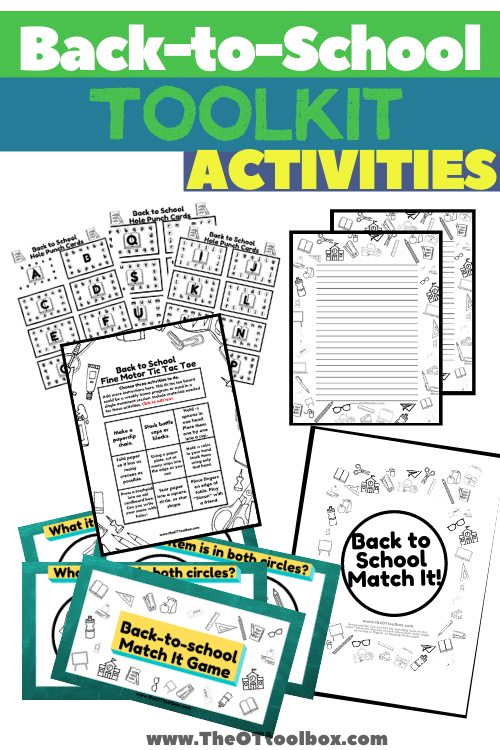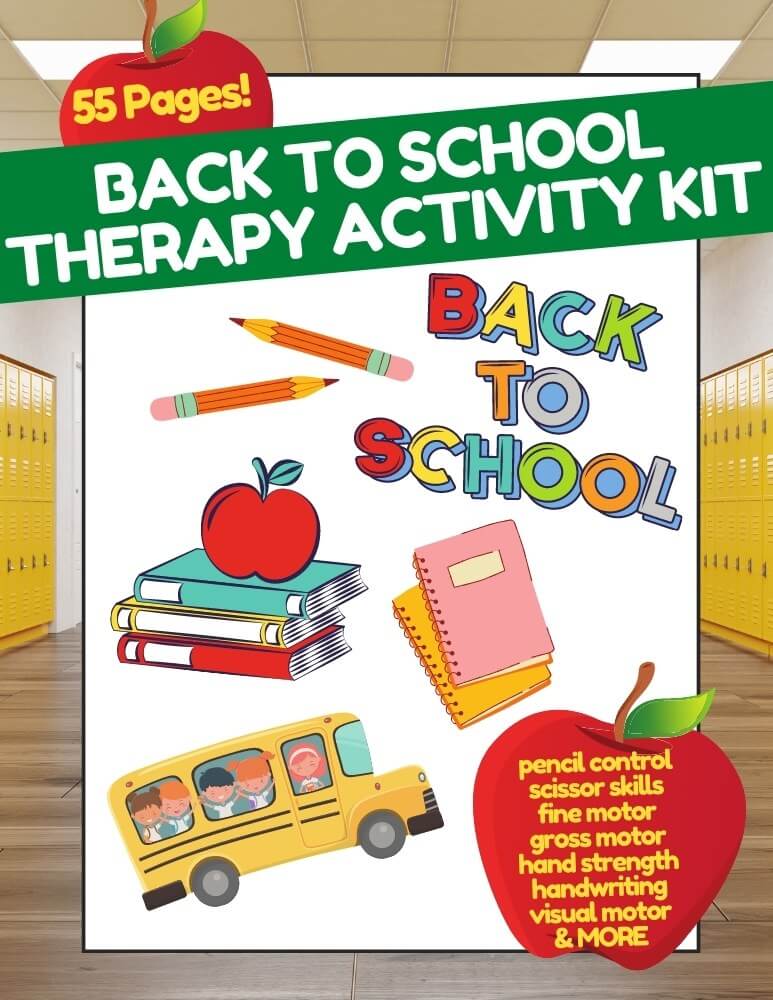Are you a new school based occupational therapist wondering how to implement a “push in” therapy service delivery model? Perhaps you have been practicing for a while and are looking for some tips to transition your services from your therapy space to the classroom. For additional reading, the OT Toolbox has a comprehensive post on occupational therapy in school system.
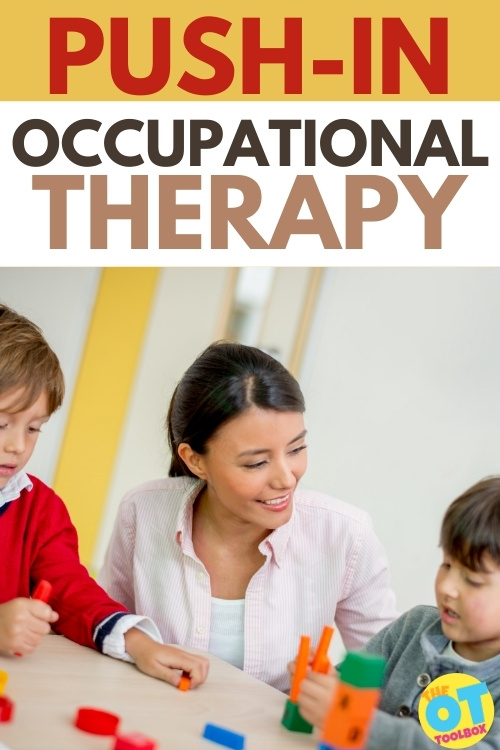
What is Push-in occupational therapy in schools?
“Push in” services is a term used to describe school based occupational therapy services provided when students are participating in their natural environments.
At school, these environments can include the classroom, the cafeteria, the playground, or any other setting that a student accesses during the school day.
Push-in Occupational Therapy Services
Changes in legislation with the addition of the No Child Left Behind law, began a shift in service delivery models for school-based occupationlal therapy over the last 20 years. This shift has refocused school based therapists on inclusion, providing services in the natural environment.
While occupational therapy in schools has always had it’s fair share of challenges (schedules and caseloads to name a few), shifting our focus to providing therapy services in the student’s natural environment, is supported by research and highlights our strengths as occupational therapists.
This challenge is a good change for related services.
Change is hard, and some stakeholders might question a change to the way occupational therapy services are delivered in school, especially if it’s always been done a certain way. We can rely on evidence, but what does it say about push in services in the school environment?
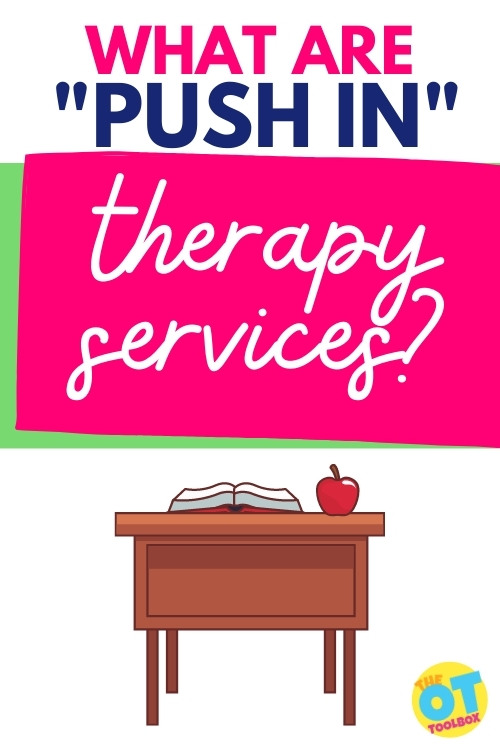
Are push in services as effective as pull out?
Yes! Push in services can be just as effective, or even more so, than pull out. Several studies (Reid et al, Villeneuve) have examined school-based services and the effectiveness of collaborative consultation.
Not only do students make progress at a faster rate, teachers and parents report improved satisfaction as well. Many occupational therapists can probably relate to the experience of having a teacher ask you what “magic” you performed with a student while in a pull out therapy session.
One of the huge benefits of push in therapy, is doing that “magic” in context so other educators can see it happening in real time!
As a school based occupational therapist, it might feel easier or more effective to pull your students out of class into a controlled therapy room to provide intense one on one therapy.
While your session might feel successful, it is not realistic. The difficulties your student is having is within the classroom, not the self contained therapy room.
How do you make the shift from pull out to push in? First, you need the support of your special education team – the parents, administrators, and teachers. Get this support by teaching and showing them what you know, and the benefits of being in the classroom.
It will take time to earn their trust, as you are seen as an intruder in their classroom.
Conducting Observations during Push-In Therapy
The first step is conducting observations of your students during the evaluation process. These observations should take place across school environments where they are engaged in occupations and activities of daily living.
This can include the playground, cafeteria, mainstream class, special education, resource, art, computer, library, or all of the above.
It is important to try to gather information from the teacher and parents to narrow your focus and understand their concerns, before deciding when and how to observe a student.
Depending on the areas of difficulty, you may need to observe transitions for children, work time, managing clothing at arrival/dismissal, the lunch routine in the cafeteria, or their ability to access the playground at recess.
Push-in Services and Goals
Once your evaluation is complete and you are recommending occupational therapy services in the natural environment to the team, how do you get teacher and parent buy-in? This may take time, and more importantly, it will take data collection.
Here is a breakdown of the fine motor skills needed at school to help with your goals setting and data collection.
One of the most important factors in success will be writing goals and objectives that are clear enough for anyone to observe the skills and collect data.
Clear, measurable, observable behaviors and/or skills need to be documented in the IEP or 504. It needs to be measurable, relevant, and doable!
Check out the SMART goals ladder worksheet on the OT Toolbox for information on creating goals.
The OT Toolbox has a great resource available for Occupational Therapy documentation in the school setting.
When educators feel empowered to carry out OT interventions, the success of the students will increase. Additionally, when parents can easily observe skills at home, they will be more supportive of the therapy model.
When the skills being addressed are supported throughout the school day and at home, students have a much greater possibility of generalizing those skills across all environments.
OT Collaboration in the classroom
As you begin to provide push in occupational therapy services for your students, it is important to collaborate with the team.
While the Occupational Therapist provides services in the natural environment teachers and/or paraeducators can observe, ask questions, and get feedback from the therapist. The entire team will be the ones implementing your interventions and collecting data when you are not there.
It is essential they feel confident in executing your interventions.
Ways to build collaboration as a school-based OT:
- Set the tone through open and reciprocal communication that all members of the team are valued and equal. Get input from all members of the team including; teachers, paraeducators, parents, and the student.
- Provide modeling for staff. Advocate to administrators it is critical for staff involved to observe you working with a student on their occupations.
- Provide coaching to the educators implementing your plan. Once you have been able to model for staff, spend time observing and coaching them while they are working with the student. We explain this in great detail in our blog post on executive function coaching.
- Make data collection easy and doable. Develop simple, easy to use data collection forms that do not require time and/or effort to complete. It could be as simple as a tally mark or checking a box on a chart.
- Check back in with the team frequently to monitor how it’s going and to make changes to the plan if needed.
One final thought… keep the focus on participation and occupation! The team will see results and your students will find success. Don’t be afraid to let your school community see the value occupational therapy adds to your student’s participation in school!
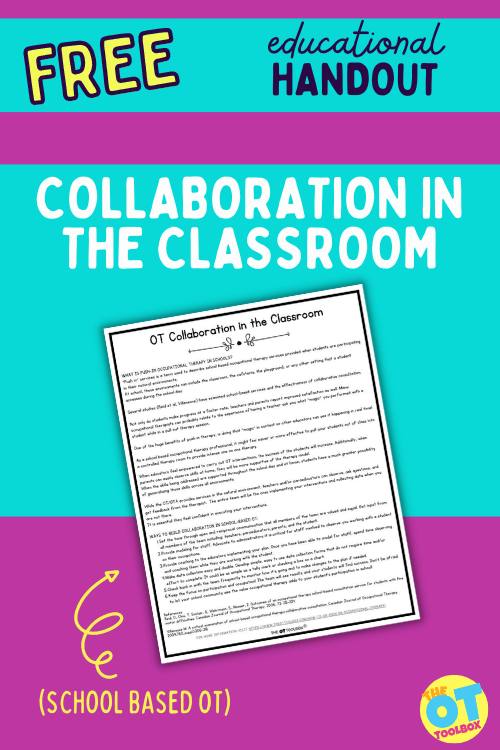
Free OT Collaboration Handout
Want a free printable handout explaining OT collaboration in the school environment? This is a useful tool for school-based occupational therapy practitioners to explain OT services in the educational model as a collaborative member of the team.
Enter your email address into the form below, and the handout will be delivered to your inbox. Or, if you are an OT Toolbox Member’s Club member, log in and then head to Educational Handouts section of the membership. Not a member? Join today and access hundreds of free resources here on the website without having to enter your email address for each item. Plus gain new resources each month.

Katherine Cook is an occupational therapist with 20 years experience primarily working in schools with students from preschool through Grade 12. Katherine graduated from Boston University in 2001 and completed her Master’s degree and Certificate of Advanced Graduate Study at Tufts University in 2010. Katherine’s school based experience includes working in integrated preschool programs, supporting students in the inclusion setting, as well as program development and providing consultation to students in substantially separate programs. Katherine has a passion for fostering the play skills of children and supporting their occupations in school.
References
Reid, D., Chiu, T. Sinclair, G, Wehrmann, S., Naseer, Z. Outcomes of an occupational therapy school-based consultation service for students with fine motor difficulties. Canadian Journal of Occupational Therapy. 2006; 73: 215-224.
Villeneuve M. A critical examination of school-based occupational therapy collaborative consultation. Canadian Journal of Occupational Therapy. 2009;76(1_suppl):206-218.
Add this handout to our other school resources:


